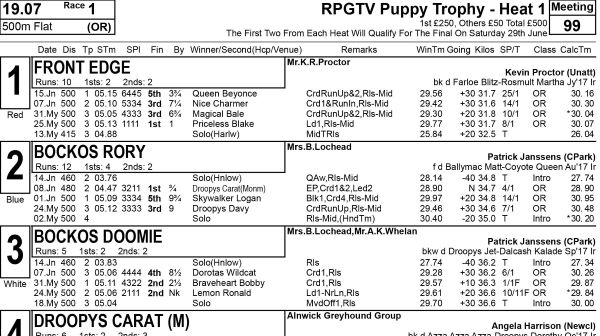Definitely, there are several factors in a Greyhound’s form that significantly influence betting odds including the greyhound’s performance history, health condition, track conditions, and the expertise of the trainer, among other things. An understanding of these aspects can greatly improve one’s betting strategy.
Greyhound’s Performance History
First and foremost, the dog’s racing history provides substantial information about their potential. High consistency in previous races, especially on a similar surface or distance, indicates high reliability. In terms of quantifiable statistics, look at the following specific factors:
- Winning Frequency: One of the most predictive factors; higher past winning leads to shorter odds.
- Finishing Position: Consistent top-3 finishes can be a sign of a competitive greyhound.
- Time: The time the greyhound has finished at in various distances directly points towards their speed and agility.
A table summarizing the above could look as follows:
| Factor | Impact on Betting Odds |
|---|---|
| Winning Frequency | Shortens Odd |
| Consistent Top-3 Placement | Shortens Odd |
| Faster Finishing Time | Shortens Odd |
Health Condition
Whether a greyhound is in prime health condition plays a crucial role in determining their form and ultimately their betting odds. Factors such as recent injuries, general well-being, and age factor into a dog’s overall health, and will affect their odds as follows:
- Recent or Ongoing Injuries: These raise questions about a dog’s ability to compete, lengthening odds.
- Age: Younger dogs (1.5-2.5 years old) are often at their prime, leading to shorter odds, while much older dogs tend to have longer odds due to the natural decrease in physical prowess.
- Well-being: Visible signs of ill health (such as being underweight or overheated) could lengthen odds.
Track Conditions
A greyhound’s affinity towards certain track conditions plays a significant role in determining their form and subsequent betting odds. Elements like track surface, weather, and distance of the race can heavily influence a dog’s performance:
- Track Surface: Greyhounds may favor certain types of surfaces (such as sand or grass) over others.
- Weather: Certain dogs excel in dry weather while others perform under wet conditions.
- Distance: Some greyhounds are sprint racers, while others are distance runners.
Trainer’s Expertise
Lastly, the proficiency of a greyhound’s trainer plays into the odds set for a race. Successful trainers are likely to have well-trained, top-performing dogs. Therefore, the more renowned or successful a trainer, the shorter the odds on their greyhounds are likely to be. In this case, the most prominent factors include:
- Past Success: The number of wins a trainer has had in past races can directly influence their current dog’s odds.
- Specialty: Certain trainers specialize in specific breeds or race types, potentially giving their greyhounds an edge.
Digging into each of the aforementioned factors can yield a more comprehensive assessment of a greyhound’s form and consequently, more accurately predict betting odds. Fundamental to this exploration is the acceptance that it’s variables in combination that truly determine the outcome of a race, and to a degree, the odds set for that race. Each factor interweaves with the others, creating a complex yet intriguing landscape for greyhound racing bettors to navigate.
Impact of Preferred Box Position
Greyhounds often display a preference for a particular starting box, which can influence their performance in a race. Observing these patterns is crucial when reviewing a dog’s form, as it can aid in predicting its performance in a specific race depending on the assigned box position. The preferred box position can vary widely between greyhounds and doesn’t necessarily correspond to a specific box number but can often refer to being an ‘inside’ or ‘outside’ runner.
The main factors related to box position that could impact the odds are:
- Inside Box Preference: Some dogs perform better when they are closer to the rail, preferring boxes 1,2,3.
- Outside Box Preference: Other greyhounds excel when they are in the outer lanes, typically favoring boxes 6,7,8.
- Middle Box Comfort: Certain greyhounds seem unfazed by their box position and do well from the middle boxes 4,5.
| Box Preference | Impact on Betting Odds |
|---|---|
| Inside Preference | Shortens Odds if in boxes 1,2,3 |
| Outside Preference | Shortens Odds if in boxes 6,7,8 |
| Middle Comfort | Shortens Odds if in boxes 4,5 |
Race Strategies
Greyhounds often employ particular race strategies depending on their running style, which can have a significant effect on the betting odds. For instance, some may be rapid breakers out of the boxes, trying to lead from the front, while others may be strong finishers, coming from behind to triumph. These different strategies are key factors to consider:
- Early Speed or Breakers: These dogs are typically faster out of the gate and try to maintain their lead throughout the race.
- Middle Pace Runners: These greyhounds often run well during the middle of the race, gambling on the front-runners slowing down as the race progresses.
- Strong Finishers or Closers: These dogs usually save their energy for the end, coming from behind to overtake their tired competitors.
| Race Strategy | Impact on Betting Odds |
|---|---|
| Early Speed | Shortens Odds |
| Middle Pace Runners | Variable Effect |
| Strong Finishers | Can Lengthen Odds Earlier in Betting Process, Odds Shorten Nearer to Race Start |
Breeding and Pedigree
The breeding lines of a greyhound can also impact betting odds. If a greyhound is from a successful lineage of racers, it’s often considered to have an increased chance of performing well. Breeders might prefer certain ‘bloodlines’ known for speed, endurance, agility, or a combination of these traits.
Factors to consider when thinking about breeding and pedigree:
- Lineage: A strong racing heritage can positively influence a greyhound’s performance and therefore affect odds.
- Breed Traits: Certain breeds of greyhounds are known for specific traits such as speed, stamina, or agility, which can factor into odds.
- Parental Success: If a greyhound’s parents have been successful racers, their offspring may receive shorter odds.
Analyzing the aforementioned sub-factors provides different dimensions for calculating a greyhound’s form and predicting how that might influence betting odds. Nevertheless, it’s vital to remember the interplay between these factors when making betting decisions, as outcomes rely on a balance of multiple variables, not merely isolated aspects.
Competing Greyhounds’ Form
Another critical factor affecting a greyhound’s betting odds is the form of competing greyhounds in a race. Strong competition or a highly talented field of greyhounds can affect the odds for individual dogs. To make more accurate betting predictions, these aspects of the competition should be considered:
- Field Strength: A race with multiple high-performers will lengthen the odds for all greyhounds involved.
- Similar Running Styles: When several greyhounds in a race have the same running style, they may interfere with one another, potentially affecting individual odds.
- Historical Match-ups: Past races featuring the same set of competing greyhounds give insight into their performance against each other.
| Competition Factor | Impact on Betting Odds |
|---|---|
| Strong Field | Lengthens Odds |
| Similar Running Styles | Variable Effect on Odds |
| Historical Match-ups | Affects Odds Based on Past Performances |
Track-Specific Performance
Some greyhounds are particularly skillful on specific tracks and might have a history of success at certain venues. This expertise is relevant when considering the factors that influence a greyhound’s betting odds. Pay attention to the following:
- Familiarity with the Track: Greyhounds that are well-acquainted with a specific track could have an edge over their opponents, shortening their odds.
- Track Record: A history of success at a specific track may be indicative of future performance and affect odds accordingly.
- Track Configuration: Some greyhounds may prefer tracks with unique features, such as more turns, different slopes, or specific track materials.
| Track-Specific Factor | Impact on Betting Odds |
|---|---|
| Track Familiarity | Shortens Odds |
| Track Record | Influences Odds Based on Success |
| Track Configuration | Shortens Odds for Suited Greyhounds |
Yet-to-be Proven Greyhounds
Greyhounds new to racing or transitioning from a different class of races can be harder to predict and might impact betting odds due to a lack of information on their form. When considering yet-to-be proven greyhounds, pay attention to these elements:
- Debutantes: Greyhounds making their racing debut can potentially offer longer odds due to a lack of historical data on their ability.
- Transitioning Greyhounds: Greyhounds moving between different race classes or distances may affect their form and consequently their odds.
- Returning Greyhounds: Greyhounds returning from injury, or a long break, may have their odds lengthened due to concerns about their form and fitness.
| Yet-to-be Proven Factor | Impact on Betting Odds |
|---|---|
| Debutantes | Lengthens Odds |
| Transitioning Greyhounds | Variable Effect on Odds |
| Returning Greyhounds | Lengthens Odds |
As greyhound racing relies heavily on the form and other contributing factors of individual dogs, bettors must consider various elements when determining a greyhound’s potential and predicting betting odds. Appreciating the complexities of interconnected factors and their influence is crucial for achieving more accurate predictions and subsequently making informed betting decisions.
Track Bias
Sometimes, certain tracks may show a pattern favoring particular types of runners or specific box positions. Understanding track bias can give informed punters an edge when estimating a greyhound’s odds in relation to the dog’s running style and starting box position.
Some track bias factors include:
- Inside Bias: Whether the track typically favors greyhounds starting from the inner boxes.
- Outside Bias: If the track generally benefits greyhounds from outer boxes.
- Bias for Running Styles: Certain tracks might favor early speed, strong finishers, or middle pace runners.
| Track Bias Factor | Impact on Betting Odds |
|---|---|
| Inside Bias | Shortens Odds for Inner Box Runners |
| Outside Bias | Shortens Odds for Outer Box Runners |
| Style Bias | Adjusts Odds Based on Running Style |
Grading and Classification
Greyhounds are usually classified into grades that denote the level of competition. This classification plays a significant role in determining betting odds. The specifics often depend on the jurisdiction, but common elements include:
- Ability-Based Classification: Greyhounds are frequently classified by ability, affecting the level of competition they face.
- Moving Up or Down Grades: A greyhound moving up in class faces tougher competition, which may lengthen odds. Conversely, if a greyhound is dropping in class, the odds often shorten, as they’re now among weaker competition.
- Consistency in Specific Grades: If a greyhound consistently performs well in its current grade, it can influence their odds favorably.
| Grading Factor | Impact on Betting Odds |
|---|---|
| Ability Classification | Shortens Odds for Higher Grades |
| Grade Transition | Lengthens Odds for Moving Up, Shortens for Moving Down |
| Consistency in Grade | Shortens Odds |
Historical Weight Trends
Greyhounds’ weight can fluctuate due to various conditions, including physical health, age, and recent racing history. Consistent weight often suggests good health and condition, which can positively influence odds. Conversely, dramatic weight shifts might signal potential problems. When considering weight trends:
- Stable Weight: Consistency in weight may lead to shorter odds as it often indicates good health.
- Weight Gain: This could potentially lengthen odds, although it may signify improved condition if the dog was previously underweight.
- Weight Loss: Severe weight loss may cause concern and hence lengthen odds unless the change was intended for improved performance.
| Weight Trend Factor | Impact on Betting Odds |
|---|---|
| Stable Weight | Shortens Odds |
| Weight Gain | Lengthens Odds Depending on Reason |
| Weight Loss | Lengthens Odds Depending on Reason |
By observing and analyzing these sub-factors, punters can get a comprehensive view of how a greyhound’s form influences the betting odds. However, it’s crucial to remember that while each of these aspects provides insight, a combination of factors is more indicative of the greyhound’s chances and subsequent betting odds.
Trainer Effectiveness
The competence of a greyhound’s trainer can have a significant impact on the dog’s performance and corresponding betting odds. A highly skilled trainer with a good track record can positively influence a greyhound’s odds. Factors to consider include:
- Trainer’s Win Rate: A trainer with a history of conditioning successful greyhounds could influence shorter odds.
- Specific Race Success: Some trainers specialize in specific types of races. A greyhound trained by someone with expertise in a given race type could see favorable odds.
- Improvement Under Currently Assigned Trainer: A greyhound showing considerable improvement under a new trainer may get shorter odds.
| Trainer Effectiveness Factor | Impact on Betting Odds |
|---|---|
| Trainer’s Win Rate | Shortens Odds |
| Specific Race Success | Shortens Odds |
| Improvement Under Trainer | Shortens Odds |
Weather Conditions
Like all outdoor sports, the condition of the weather can have significant implications on a race’s outcome. This factor becomes more critical when a greyhound has a proven record of performing better or worse in specific weather conditions.
- Rain: Wet conditions could affect a greyhound’s grip on the track. A dog known to run well in wet conditions might see shortened odds on a rainy day.
- Temperature: Extreme temperatures could affect a greyhound’s performance. Dogs that excel in hot or cold weather might see shorter odds under those conditions.
- Humidity: Just like temperature, humidity could impact a greyhound’s respiratory efficiency. Dogs known to do well in high or low humidity could see corresponding changes in odds.
| Weather Conditions Factor | Impact on Betting Odds |
|---|---|
| Rain | Variable Effect on Odds |
| Temperature | Variable Effect on Odds |
| Humidity | Variable Effect on Odds |
Age and Experience
A greyhound’s age and racing experience can predictably influence their form and the betting odds. While some excel at a young age, other dogs may become better as they grow older and gain more experience.
- Young Greyhounds: These are often less predictable but may offer enticing longer odds due to their potential and less established form.
- Prime Age Greyhounds: These dogs are generally in their prime racing age and might see shorter odds due to proven form.
- Experienced Greyhounds: These dogs, if still maintaining good form, could have shorter odds because of their experience on the track.
| Age and Experience Factor | Impact on Betting Odds |
|---|---|
| Young Greyhounds | Variable Effect on Odds |
| Prime Age Greyhounds | Shortens Odds |
| Experienced Greyhounds | Variable Effect on Odds |
All these factors make the odds calculation a complex task, requiring the assimilation of countless variables and considerable expertise in greyhound racing. It’s crucial to remember that each greyhound’s odds reflect their perceived probability of winning, which can be influenced by numerous interconnected elements.




